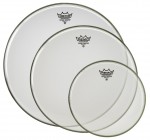
Drum ‘Heads’ or ‘Skins’ – The membrane that covers the open end(s) of a drum shell, usually made of animal skin or mylar composites
Batter head – A head designed for use on the side of the drum being struck
Resonant head – A head (usually thinner) designed for use on the side of the drum not being struck.
Limbs – Your arms and legs.
Rhythm – A pattern in time. Usually in musical language it means some or all of the pulses in a framework of steady pulses, like 8th notes or 16th notes.

‘Pulse Rhythm’ – A rhythm made with a constant steady sound (like water dripping from a faucet).

Tempo – The pace of music, measured in BPM’s (beats per minute). Specified as ‘quarter notes per minute’ (q =110 bpm) or ‘eighth notes per minute’ (8th =183 bpm) .
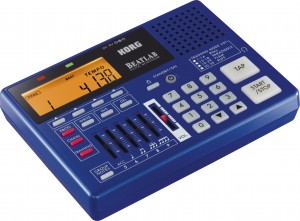
Metronome – A device that plays steady pulses or ‘pulse rhythms’ at any tempo. Useful for training your timing abilities.

Triplets – Three notes in the space of one note (i.e. three eighth notes in one quarter note). These are usually indicated by a ‘3’ above the note grouping.
(Not to be used when describing a cluster of three notes in a non-triplet feel).
Notehead – The main part of a note. Can be a dot, x, triangle, diamond, etc.

Stem – The vertical line attached to the notehead.
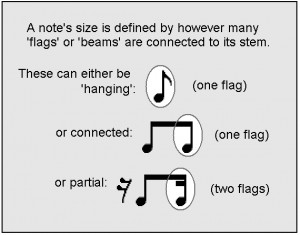
Flag/Beam – The ‘tail’ of a note attached to the stem, either hanging like a flag or connected (or partially connected) between more than one stem.
Measure (or ‘bar’) – A ‘container’ for notes. It is a variable length of music, used as the main building block for songs and music.

Time signature – The length of a measure, for example ‘six eighth notes’ (6/8 time) or ‘four quarter notes’ (4/4 time).
Barlines – The vertical lines that indicate the beginnings and endings of bars/measures. When they have dots (like below), they are ‘repeats’.
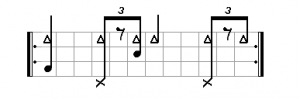
Grid Notation – The style of measures which includes a grid behind the notes, to represent all the counts in a measure, for easy understanding. This style is used in most of Adam’s instructional materials and by many others in the drumming community.
Beat – The main pulse in a measure, with a note type indicated by the bottom number of a time signature. These pulses are usually counted by numbers (i.e. “there is a crash cymbal during beat 3”).

Drum beat – This term is out of style; ‘groove’ is the new ‘beat’. It’s less confusing to keep the definition of ‘beat’ to the one listed above.
Groove – A repetitive pattern played on drums, percussion, and/or a drumset. This is most of what a drummer usually plays during songs.
Four-On-The-Floor – Quarter notes on the bass drum during a groove in 4/4 time. This is most common in danceable styles of music and electronica, as well as swing music.
Four-Up – Quarter notes on the snare drum during a groove in 4/4 time. Examples can be found easily in the Motown era of grooves and in various modern music.
Muscle Memory – Your ‘habit forming’ ability to execute a physical action without requiring thought-processes.
Your Musical Vocabulary – Your familiar selection of the ‘language’ of music that you can remember and execute at will. This includes phrases, grooves, fills, rhythms, licks, and anything else that fits this description.
Your Rhythmic Vocabulary – The part of your musical vocabulary having to do with only rhythms. This is an important concept that can be used to build your creativity.
Endurance – Your ability to play and maintain a pattern at length, without breaks or mistakes. This is an important concept in building speed and control.
Agility – Your ability to move quickly and accurately around the drumset, between various targets.
Coordination – Making sure your leather rock star pants look good with your bandanna. (kidding)
Ability to execute any combination or sequence of notes made by your four limbs.

Linear Patterns – The word ‘linear’ literally means ‘in a line’, and for drummers it refers to patterns with only one note at a time. The common ‘Songo’ groove is a classic example of this.
Layered Patterns – Patterns made of multiple rhythms being played at the same time, which causes notes to happen one at a time and/or together.
Stroke – A single movement to strike something with a drumstick or pedal. A full stroke includes both the ‘downstroke’ and the ‘upstroke’ in one motion.
Downstroke/Forward-swing – The part of the stroke that brings the stick or beater from its starting point to impacting the playing surface.
Upstroke/Backswing – The part of the stroke that brings the stick or beater back from the playing surface to its resting point.
‘Standard Rudiments’ – A collection of basic snare vocabulary intended as a basis for marching drumming, often used as a foundation of sticking skills for drumset players. View rudiments and read more about them on the Vic Firth website
‘Sticking’ or Sticking Pattern – A linear sequence of ‘right’ and ‘left’ hands used to create a rhythm.
Single Strokes, Alternating Strokes, or ‘Singles’ – A linear sticking pattern, made by alternating hits between any two limbs, usually between your hands or between your feet. Included in rudiments.
(ex. R-L-R-L-R-L-R-L…)
Double Strokes or ‘Doubles’ – A linear sticking pattern, made by alternating two hits per limb between any two limbs, usually between your hands or between your feet. Included in rudiments.
(ex. R-R-L-L-R-R-L-L…)
Roll – A smooth continuous sound made on any percussion instrument, created by single strokes, double strokes, or ‘multiple bounce’ / ‘buzz’ strokes. This is a category of the rudiments.
Paradiddle – A repeating linear pattern between two limbs, made by the sequence of R-L-R-R-L-R-L-L. Included in rudiments.
Diddle – A British word for two bounces in one stroke, as in a ‘double stroke’ (ex. R-R or L-L).
Flam – An almost simultaneous hit between two limbs, where the first limb plays a ‘grace note’ that is softer than the ‘main note’ following it. This is a category of rudiments.
Drag – Like a flam, only using a ‘diddle’ instead of a single grace note. Also a category of rudiments.
‘Running Hi-hats’ – This term refers to alternating strokes on the hi-hat during a groove.
Mute, Choke – To stop the sustain of a sound during or after its creation, to create a ‘staccato’ sound.
Sustain – The length of a sound allowed to decay on its own. (Example: A crash cymbal has longer sustain than a snare drum).
Rim-knock – A woodblock-like sound made by keeping the tip of a stick in contact with a snare drum head, while the stick body hits the rim.
Rim-shot – A loud crack made by simultaneously hitting the rim of a snare with the shoulder or body of a stick, while the tip of the stick hits the head.
Fill – An embellishment or ‘decoration’ on a groove, typically played on snare and/or toms. Often used to catch attention, signal a change between sections of a song, and/or generate intensity in a groove… or just for fun.
Phrase – A musical idea of any length.
Mindfulness – The state of being aware and focused on your present experience.
Meditation – A practice which develops mindfulness and focus.
Soul – Eaten by demons. Also a quality music is said to have, when it feels expressive and alive.
Emotion – A quality of music, often more complex or generic than the common ‘happy-sad-angry-afraid’ emotions.
Feel – The experience of energy, either as tactile (touch), an emotional sense, or an energetic sense. Feeling various parts of your experience of drumming helps you learn faster and perform better.
Rehearsing – Repeating a piece of music accurately and at length, to develop your habits for executing it.
Ambidexterity – The ability to use the right and left sides of your body equally. Highly prized in drumming.
Transcription – A written / visual version of a piece of existing music.
Classical Terms In Music
Crescendo (<) – Increasing volume
Decrescendo (>) – Decreasing volume
Pianissimo (pp) – Very quiet
Piano (p) – Quiet
Mezzo Piano (mp) – Medium-quiet
Mezzo Forte (mf) – Medium-loud
Forte (f) – Loud
Fortissimo (ff) – Very Loud
Staccato (indicated by a dot above a note) – No sustain, short note
Legato (indicated by a dash above a note) – Full sustain
Accelerando – Increasing tempo
Diminuendo – Decreasing tempo
Capo – The beginning of a piece of music
Fine – The end of a piece of music
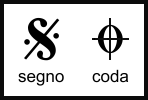
Segno (the ‘sign’) – A marker used as a destination during a piece of music
Coda – A marker used as a destination during a piece of music, usually at or near the end
Dal Capo Al Fine (D.C. al Fine) – Go to the beginning of the piece, then end the song where you see ‘fine’.
Dal Segno Al Fine (D.S. al Fine) – Go to the ‘sign’ and then locate end the song where you see ‘fine’.
Dal Segno Al Coda (D.S. al Coda) – Go to the ‘sign’ and then jump to the Coda when you see the ‘To Coda’ link.
